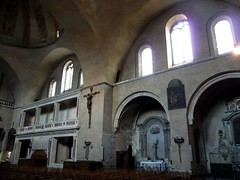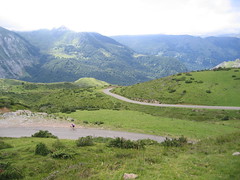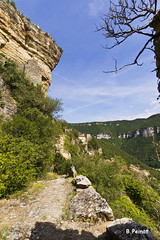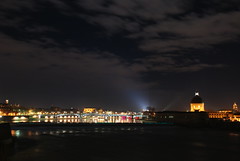Midi-Pyrénées
The Pyrenees (English: /ˈpᵻnz/; Spanish: Pirineos Spanish: [piɾiˈneos]; French: Pyrénées French: [piʁene]; Catalan: Pirineu Catalan: [piɾiˈnɛw]; Basque: Pirinioak Basque: [piɾini.o.ak]; Occitan: Pirenèus Occitan: [piɾeˈnɛws]; Aragonese: Pirineus) is a mountain range straddling the border of France and Spain. It extends nearly from its union with the Cantabrian Mountains to Cap de Creus on the Mediterranean coast. It reaches a maximum altitude of at the peak of Aneto.
For the most part, the main crest forms a divide between Spain and France, with the microstate of Andorra sandwiched in between. Historically, the Crown of Aragon and the Kingdom of Navarre extended on both sides of the mountain range.
Etymology
In Greek mythology, Pyrene is a princess who gave her name to the Pyrenees. The Greek historian Herodotus says Pyrene is the name of a town in Celtic Europe. According to Silius Italicus, she was the virgin daughter of Bebryx, a king in Mediterranean Gaul by whom the hero Hercules was given hospitality during his quest to steal the cattle of Geryon during his famous Labours. Hercules, characteristically drunk and lustful, violates the sacred code of hospitality and rapes his host's daughter. Pyrene gives birth to a serpent and runs away to the woods, afraid that her father will be angry. Alone, she pours out her story to the trees, attracting the attention of wild beasts who tear her to pieces.
After his victory over Geryon, Hercules passes through the kingdom of Bebryx again, finding the girl's lacerated remains. As is often the case in stories of this hero, the sober Hercules responds with heartbroken grief and remorse at the actions of his darker self, and lays Pyrene to rest tenderly, demanding that the surrounding geography join in mourning and preserve her name: "struck by Herculean voice, the mountaintops shudder at the ridges; he kept crying out with a sorrowful noise 'Pyrene!' and all the rock-cliffs and wild-beast haunts echo back 'Pyrene!' … The mountains hold on to the wept-over name through the ages." Pliny the Elder connects the story of Hercules and Pyrene to Lusitania, but rejects it as fabulosa, highly fictional.
Other classical sources derived the name from the Greek word for fire, (IPA: /pŷːr/).Dictionary of Greek and Roman Geography (1854) William Smith, LLD, Ed.tufts.edu According to Greek historian Diodorus Siculus "in ancient times, we are told, certain herdsmen left a fire and the whole area of the mountains was entirely consumed; and due to this fire, since it raged continuously day after day, the surface of the earth was also burned and the mountains, because of what had taken place, were called the Pyrenees."
Geography
Physiographical divisions
Physiographically, the Pyrenees may be divided into three sections: the Atlantic (or Western), the Central, and the Eastern Pyrenees. Together, they form a distinct physiographic province of the larger Alpine System division.
In the Western Pyrenees, from the Basque mountains near the Bay of Biscay of the Atlantic Ocean, the average elevation gradually increases from west to east.
The Central Pyrenees extend eastward from the Somport pass to the Aran Valley, and they include the highest summits of this range:
- Pico de Aneto in the Maladeta ridge,
- Pico Posets ,
- Monte Perdido .
In the Eastern Pyrenees, with the exception of one break at the eastern extremity of the Pyrénées Ariégeoises in the Ariège area, the mean elevation is remarkably uniform until a sudden decline occurs in the easternmost portion of the chain known as the Albères.
Foothills
Most foothills of the Pyrenees are on the Spanish side, where there is a large and complex system of ranges stretching from Spanish Navarre, across northern Aragon and into Catalonia, almost reaching the Mediterranean coast with summits reaching . At the eastern end on the southern side lies a distinct area known as the Sub-Pyrenees.
On the French side the slopes of the main range descend abruptly and there are no foothills except in the Corbières Massif in the northeastern corner of the mountain system.
Geology
The Pyrenees are older than the Alps: their sediments were first deposited in coastal basins during the Paleozoic and Mesozoic eras. Between 100 and 150 million years ago, during the Lower Cretaceous Period, the Bay of Biscay fanned out, pushing present-day Spain against France and applying intense compressional pressure to large layers of sedimentary rock. The intense pressure and uplifting of the Earth's crust first affected the eastern part and moved progressively to the entire chain, culminating in the Eocene Epoch.
The eastern part of the Pyrenees consists largely of granite and gneissose rocks, while in the western part the granite peaks are flanked by layers of limestone. The massive and unworn character of the chain comes from its abundance of granite, which is particularly resistant to erosion, as well as weak glacial development.
The upper parts of the Pyrenees contain low-relief surfaces forming a peneplain. This peneplain originated no earlier than in Late Miocene times. Presumably it formed at height as extensive sedimentation raised the local base level considerably.
Landscape
Conspicuous features of Pyrenean scenery are:
- the absence of great lakes, such as those that fill the lateral valleys of the Alps
- the rarity and relative high elevation of usable passes
- the large number of the mountain torrents locally called gaves, which often form lofty waterfalls, surpassed in Europe only by those of Scandinavia
- the frequency with which the upper end of a valley assumes the form of a semicircle of precipitous cliffs, called a cirque.
The highest waterfall is Gavarnie (462 m or 1,515 ft), at the head of the Gave de Pau; the Cirque de Gavarnie, in the same valley, together with the nearby Cirque de Troumouse and Cirque d'Estaubé, are notable examples of the cirque formation.
Low passes are lacking, and the principal roads and the railroads between France and Spain run only in the lowlands at the western and eastern ends of the Pyrenees, near sea level. The main passes of note are:
- Col de la Perche , towards the east, between the valley of the Têt and the valley of the Segre,
- Col de Puymorens , on European route E09 between France and Spain.
- The nearby he Pas de la Casa or Port d'Envalira, the highest road pass in the Pyrenees at , and one of the highest points of the European road network, which provides the route from France to Andorra,
- The Port de la Bonaigua , in the middle of the range at the head of the Aran Valley.
- Plan de Beret
- Col du Pourtalet .
- The Col de Somport or Port de Canfranc , where there were old Roman roads.
- Col de la Pierre St Martin
- Puerto de Larrau
- The Roncevaux Pass , entirely in Navarre (Spain) is an important point on the Camino de Santiago pilgrimage route.
Because of the lack of low passes a number of tunnels have been created, beneath the passes at Somport, Envalira, and Puymorens and new routes in the center of the range at Bielsa and Vielha.
A notable visual feature of this mountain range is La Brèche de Roland, a gap in the ridge line, whichaccording to legendwas created by Roland.
Natural resources
The metallic ores of the Pyrenees are not in general of much importance now, though there were iron mines at several locations in Andorra, as well as at Vicdessos in Ariège, and the foot of Canigou in Pyrénées-Orientales long ago. Coal deposits capable of being profitably worked are situated chiefly on the Spanish slopes, but the French side has beds of lignite. The open pit of Trimoun near the commune of Luzenac (Ariège) is one of the greatest sources of talc in Europe.
Mineral springs are abundant and remarkable, and especially noteworthy are the hot springs. The hot springs, among which those of Les Escaldes in Andorra, Panticosa and Lles in Spain, Ax-les-Thermes, Bagnères-de-Luchon and Eaux-Chaudes in France may be mentioned, are sulfurous and mostly situated high, near the contact of the granite with the stratified rocks. The lower springs, such as those of Bagnères-de-Bigorre (Hautes-Pyrénées), Rennes-les-Bains (Aude), and Campagne-sur-Aude (Aude), are mostly selenitic and not hot.
Protected areas
Principal nature reserves and national parks:
- Ordesa y Monte Perdido National Park (Spain)
- Pyrénées National Park (France)
- Aigüestortes i Estany de Sant Maurici National Park (Spain)
- Posets-Maladeta Natural Park (Spain)
In 1997, part of the Pyrenees (including Ordesa y Monte Perdido National Park and Pyrenees National Park) was inscribed on the UNESCO World Heritage List for its spectacular geologic landforms and testimony to the unique "transhumance" agricultural system.
Demographics and culture
The Pyrenean region possesses a varied ethnology, folklore and history: see Andorra; Aragon; Ariège; Basque Country; Béarn; Catalonia; Navarre; Roussillon. For their history, see also Almogavars, Marca Hispanica.
The principal languages spoken in the area are Spanish, French, Aragonese, Catalan (in Andorra and in Northern and Southern Catalonia), and Basque. Also spoken, to a lesser degree, is the Occitan language, consisting of the Gascon and Languedocien dialects in France and the Aranese dialect in the Aran Valley.
An important feature of rural life in the Pyrenees is 'transhumance', the moving of livestock from the farms in the valleys up to the higher grounds of the mountains for the summer. In this way the farming communities could keep larger herds than the lowland farms could support on their own. The principal animals moved were cows and sheep, but historically most members of farming families also moved to the higher pastures along with their animals, so they also took with them pigs, horses and chickens. Transhumance thus took the form of a mass biannual migration, moving uphill in May or June and returning to the farms in September or October. During the summer period, the families would live in basic stone cabins in the high mountains.
Nowadays, industrialisation and…
Looking for places related to Midi-Pyrénées?
Those are other destinations to find places related to Midi-Pyrénées:
























